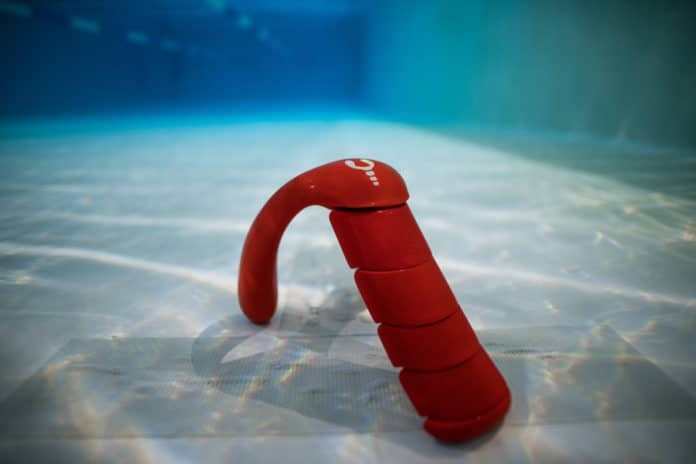Picture yourself on a boat on a river. Now take away those tangerine trees and marmalade skies, and instead imagine taking the weight from the keel of the boat and putting it on top of the highest point of your vessel. What do you think the result will be? That boat on that river will topple, for sure. Mess with the laws of nature and tangerine trees will fall upon thee.
I really wanted to like the Lobster weight. I first saw it in action in Finland, during the pool world championships of 2016, and I instantly loved the design. There is something spot on about it, timeless, fit for purpose but with a touch of humor and style. As an object it has graceful, human form-fitting lines with some alien face hugger-type details, it comes in some attractive and some horrendous colors, and it is even nice to the touch, as the weights are coated in a polyurethane plastic. I like that it comes in segments, with the main part, which goes around the neck, being a mouldable 2.5 kilos, so you can adjust it to your neck’s circumference, and the 5 additional segments which you can click on the main bit and each other, to adjust the weights to your needs, up to 4 kilos in total.
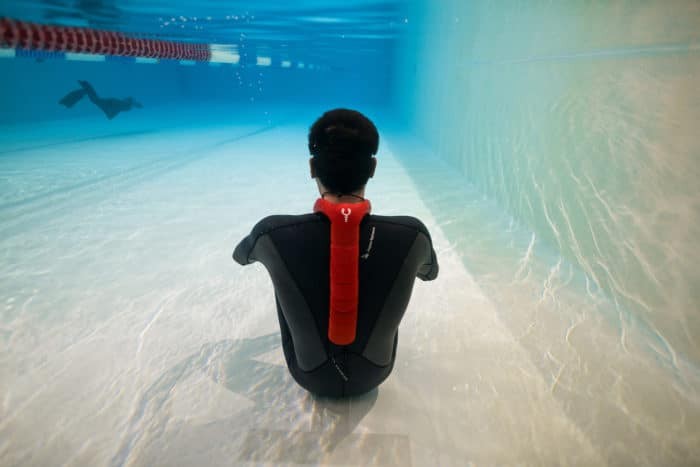
Now that’s where the first problem arises: a lot of people need more than 4 kilos. My training neck weight is a bit over 5 kilos, and if I pack like a vacuum cleaner in a hyperbaric chamber, I need 6 kilos. Of course, you can wear more weight on a belt, but the site for lobster – http://lobsterweight.com/ – says it’s used for ‘improved hydrodynamics’; having to add a weight belt to it is about as hydrodynamic as adding a wall to a whale.
For the purpose of testing, I instead decided to just not swim on a full inhale, rather than adding the wall. To test buoyancy, I have a simple test: do a push-off and see where I end up. If it’s on the surface I need more weight, if I start snorting tiles I’m probably a bit heavy. So I push off on less than a full inhale, and the second, more structural problem pops up: as my speed decreases, I find myself slowly tilting until I involuntarily flip over and end belly up on the surface.
It’s that boat on the river: too much weight too high up and you end up structurally imbalanced. This beautiful design has a fundamental flaw to it, in that it places the weight on the wrong side of the body. It’s not your spine, but your sternum that wants to be weighed down to compensate for your natural buoyancy. It is there where a weight would be most stable and best suited to be placed. As wonderful a design as the Lobster is, it is a good design for a wrong solution.
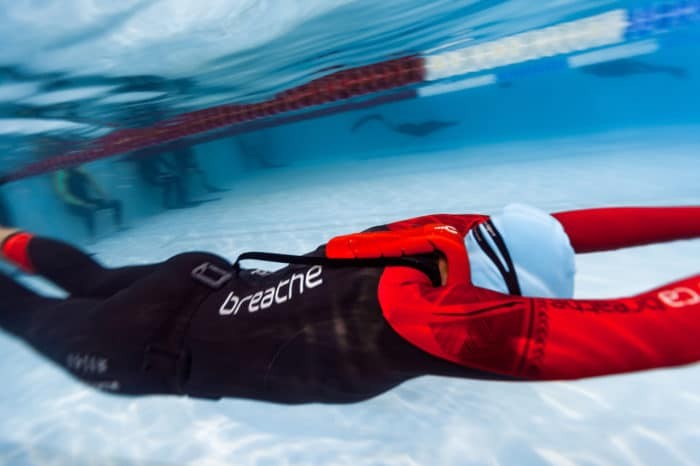
The reason old-fashioned neck weights work is that the bulk of their weight is below you, so naturally balanced. They might be visually appalling – as my grandmother asked: “Why would you wrap a dead donkey dong around your neck?” – and they’re certainly uncomfortable once they reach the 4+ kilo point and press upon the back of your neck when you’re standing upright, but they do the job. I’ve never experienced instability with a home-made neck weight like I did with the Lobster.
To be fair, we tested it on 2 club nights and while I wasn’t the only one experiencing instability, most people got on with the weight just fine. As a matter of fact, one member liked it so much she instantly bought one. When I saw the price of a Lobster my eyebrows did a bit of a jumpy thing; I know lobsters are expensive, and in the UK you’d expect to pay £30 or more per kilo, but this one is £180! That’s quite a bit of money. If you’d make your own 4-kilo neck weight, it’d cost you about £30 in materials and an hour or so of sweating and cursing. It wouldn’t be nearly as nice looking as the Lobster, but on me, it would work better. But then I’d also miss the joy of receiving a box from Moldavia; “I’ve never seen anything from there before!” said the guy at the post office. Comes in a handy bag for transportation, too.
The second night I tested it, I then had the benefit of there being a pair of Lobsters, so we could combine their ‘tails’ and make it into one, long freaky thing. This got rid of my first problem with it not being heavy enough, but aggravated the second problem of putting the ‘lop’ in lobster; I kept tilting. When my friend tried she experienced the same thing, but we both only had it at very low speeds. Maybe that’s not what the Lobster has been designed for, so I tested it with normal and high speeds as well. It works better that way. Normal speeds in no fins there’s a bit of a wobble you have to compensate for, but with a monofin, you don’t notice the wobble at all and it works fine. It stays on really well during turns, but then you notice there’s only very limited head movement before you hit the weight. I think most people look up once they get to the wall, and they’ll find the weight impedes this movement. Maybe it’s better not to look up, but I found it slightly annoying.
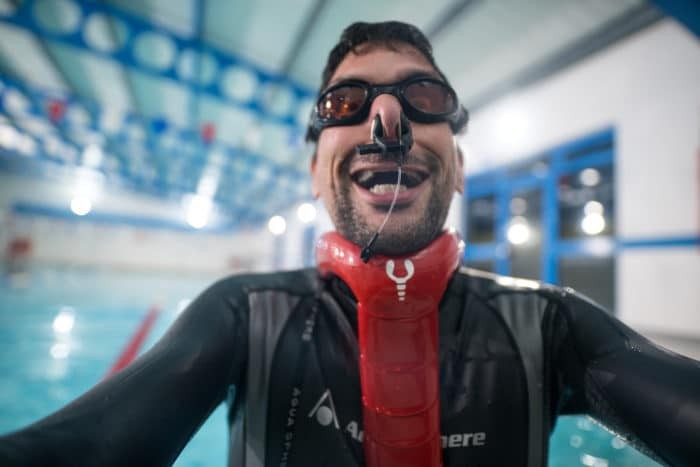
Another annoyance is when you stand up with the weight on, it rests on your collar bones. I might be particularly sensitive there, but during the club nights, several other people mentioned this. It’s not an issue during the swim, but during the breath up it is distracting to the point where you breathe up while lifting the weight. Made me want to slap the thing.
Combining all those annoyances and problems, I had a bit of an idea and decided to put the weight on the other way round, that is with the ‘tail’ on my sternum. Totally worked! Well, no, not totally, in that all of a sudden then your head is in a brace and in the wrong position, but now at least the weight is in the right place, you don’t wobble, and your collar bones are delightfully irritant-free. It’s not its intended use, and probably not a good look, but hey, gotta test these things.
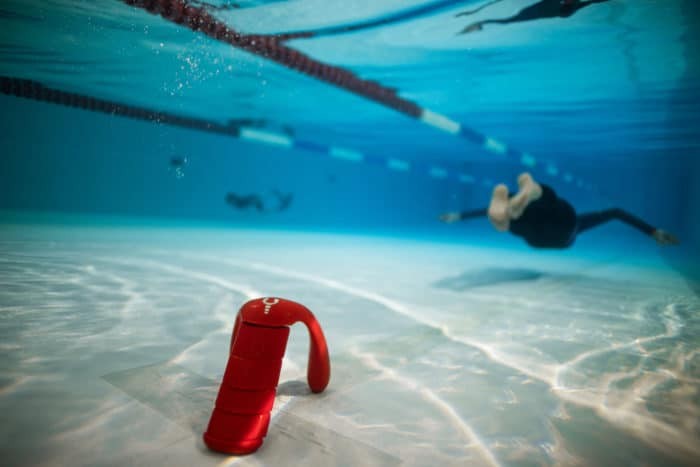
More practically, I then did an upside-down swim, and there the Lobster really shines. A normal neck weight would sorta crush your throat doing that, but the Lobster just hangs from your neck, its tail won’t flap as it can only bend in one direction, and now it’s perfectly positioned.
So the Lobster is perfect when you swim upside down. I know one athlete who does that, so I guess the Lobster is for her. For anyone else, I wouldn’t recommend it, unless you are really in love with the design and can live with its structural flaws. Some people did not experience any tilting or irritation in the collar bones and enjoyed its mouldable frame and how well it performs. I’d suggest to try it before you buy it. I really wanted it when I saw it, but having tried it, I couldn’t justify spending that much money on something that does not work for me. The perfect neck weight remains a pie in the marmalade sky.
BUY NOW – Lobsterweight.com
Features
- Anatomical shape
- Improved hydrodynamics
- Customisable weight of the device (4 kg max)
- Extra durable and nice-to-touch material
BUY NOW – Lobsterweight.com

